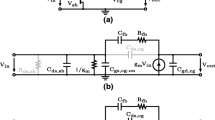Abstract
RF MEMS is a perfect candidate to replace the conventional switches used for microwave frequency. Most of the RF MEMS switches developed generally concentrate on single-pole single-throw based configurations and limited work is reported on switches based on single-pole multiple-throw. This paper reports an RF MEMS single-pole quad-throw (SPQT) switch design and modeling utilizing an axial force coupling mechanism among membranes. The proposed novel SPQT structure consists of twin pair switching membranes coupled using flexible beams. The primary advantage of such a mechanism is to increase isolation as when one switching membrane is pulled down to the ON-state, there develops an axial force on the other and hence it is turned to a better OFF state. The gap on other port increases. Hence, this enables the coupled pair of switches to achieve simultaneously a low actuation voltage, high isolation. The displacement of coupling beams is restricted by a silicon stopper and hence further amplifies the axial force. The designed 3-layer stack (Silicon Nitride/Gold/Silicon Nitride), minimizes the warpage of large membrane. The insertion loss and isolation among throws of the SPQT are simulated to be better than 0.09 and 53 dB at 2 GHz, respectively. The voltage required for actuation is 12 V while the SPQT switch has a compact area of 1 mm × 0.7 mm.



















Similar content being viewed by others
References
Cabral JM, Holmes AS (2006) A novel seesaw-type rf mems switch. In: Electrotechnical conference, 2006. Melecon 2006. ieee Mediterranean, pp 288–292
Farinelli P, El Ghannudi H, Resta G, Margesin B, Erspan M, Sorrentino R (2012) High power sp4t mems switch for space applications. In: Microwave conference (eumc), 2012 42nd European, pp 186–189
Kim C-H (2012) Mechanically coupled low-voltage electrostatic resistive rf multithrow switch. Ind Electron IEEE Trans 59(2):1114–1122
Lee H-C, Park J-H, Park J-Y, Nam H-J, Bu J-U (2005) Design, fabrication and rf performances of two different types of piezoelectrically actuated ohmic mems switches. J Micromech Microeng 15(11):2098
Rebeiz GM (2004) Rf mems: theory, design, and technology. Wiley, New York
Robin R, Touati S, Segueni K, Millet O, Buchaillot L (2008) A new four states high deflection low actuation voltage electrostatic mems switch for rf applications. In: mems/moems 2008 symposium on design, test, integration and packaging of mems/moems, 2008, pp 56–59
Shalaby MM, Abdelmoneum MA, Saitou K (2009) Design of spring coupling for high-high-frequency mems filters for wireless applications. Ind Electron IEEE Trans 56(4):1022–1030
Simons RN (2004) Coplanar waveguide circuits, components, and systems, vol 165. Wiley, New York
Singh T (2013a) Effective stress modeling of membranes made of gold and aluminium materials used in radio-frequency microelectromechanical system switches. Trans Electr Electron Mater 14(4):172–176
Singh T (2013b) From theory to development: role of multiphysics modeling and its effect on education in electronics. Electronics 17(2):105–109
Singh T (2015) Design and finite element modeling of series-shunt configuration based rf mems switch for high isolation operation in k–ka band. J Comput Electron 14(1):167–179
Singh T, Pashaie F (2014) Finite element modeling of a ti based compact rf mems series switch design for harsh environment. Microsyst Technol 1–7. DOI:10.1007/s00542-014-2329-y
Singh T, Rangra KJ (2015) Compact low-loss high-performance single-pole six-throw rf mems switch design and modeling for dc to 6 GHz. Microsyst Technol 1–10. DOI: 10.1007/s00542-015-2411-0
Singh T, Pashaie F, Kumar R (2015) Redundancy based design and analysis of ALU circuit using CMOS 180 nm process technology for fault tolerant computing architectures. Int J Comput Dig Syst 4(1):53–62
Author information
Authors and Affiliations
Corresponding author
Rights and permissions
About this article
Cite this article
Singh, T., Kaur, N. Layered axial force coupled membrane based metal contact single-pole quad-throw RF MEMS switch: design, RF performance and mechanical modeling. Microsyst Technol 22, 2117–2123 (2016). https://doi.org/10.1007/s00542-015-2623-3
Received:
Accepted:
Published:
Issue Date:
DOI: https://doi.org/10.1007/s00542-015-2623-3




